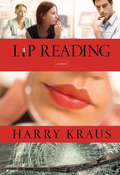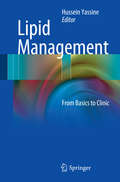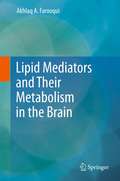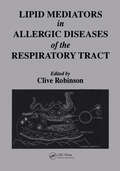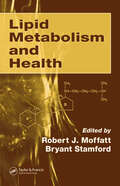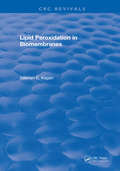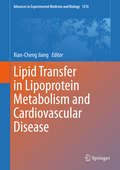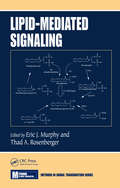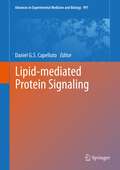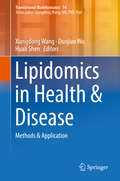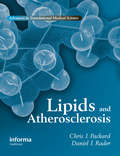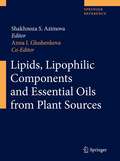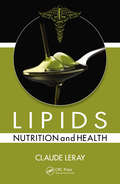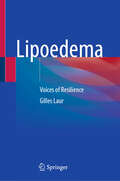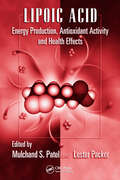- Table View
- List View
Lip Cancer
by Antonia KolokythasThis textbook is intended as a comprehensive reference that will provide easy-to-follow and well-organized guidance on the management of lip cancer, from diagnosis to treatment and reconstruction. After discussion of anatomy and premalignant conditions, detailed attention is paid to squamous cell carcinoma of the lip. Surgical management is explained, and the roles of radiation therapy and chemotherapy, discussed. Reconstruction techniques following ablative surgery are then described in depth, with reference to defect size and complexity. In addition, the potential complications of treatment and reconstruction are presented, with advice on their management. The closing chapter considers other malignant lesions of the lip. The informative text is complemented by high-quality illustrations and clinical and radiographic material. The contributors all have extensive experience and in-depth knowledge of the topics they address.
Lip Reading
by Harry KrausShe Could Save Millions, or Save Herself She just needs a little longer. She's really close. Dr. Rebecca Jackson, a medical researcher, stands on the verge of a breakthrough that will transform medicine. But she soon discovers the reason behind the miraculous progress in her research, and it leaves her with a nearly impossible choice . . . and little time to decide. More than her research is at stake. And more threatens it than this latest revelation. Something she's tried hard to cover up. There is a high cost to some things in medicine and it's not always the patient who pays. Can Rebecca find the faith and wisdom she needs to make the right call? The clock is ticking and the pressure is on.
Lipedema: A Practical Guidebook
by Zaher Jandali Lucian P. Jiga Corrado CampisiThis book is written as a guide for patients suffering from lipedema. Known as a common, painful fat distribution disorder characterised by a disproportional fat accumulation, lipedema represents an unmet medical need where scientific evidence on both pathophysiology and its treatment is still lacking. As the number of affected patients is increasing, besides striving to map the conundrum of clinical signs and relate these to their underlying mechanisms, developing standardised approaches addressing both fat mass reduction and body contouring are key issues able to warrant therapeutic success. In this book, our intention was to look at this complex disease from all its actual perspectives and provide a concise summary of the actual state of knowledge for all those affected. After looking into the most actual data on the aetiology, pathophysiology and course of the disease, the book then focuses on our complex treatment protocols wherecurrent conservative and surgical treatment options are systematically analyzed, considering their long-term chances of success as well as associated risks and side effects. We propose a three step treatment approach. 1st step initiates with weight control and addresses obesity, if present. 2nd step is an individual liposuction therapy plan to treat all lipedema areas, and more. 3rd step includes body contouring surgery, only in patients with massive skin laxity after liposuction and / or massive weight loss.
Lipid Management
by Hussein YassineThe purpose of this work is to provide an update on our understanding of lipids in the clinic using information from recent clinical trials and in special populations. This will be a concise, easy to read book. We will cover LDL, HDL and triglyceride metabolism in the first chapters. We will provide updates from recent HDL trials where raising HDL cholesterol did not translate into reduced cardiovascular events and revisit the role of HDL cholesterol in heart disease (Dr. Yassine). The vast majority of authors are confirmed. Dr. Goran will review lipids abnormalities in children with a particular focus on vulnerable populations (emphasis on ethnicity and childhood obesity). Dr. Goldberg will review the treatment goals for managing lipids in clinic. Dr. Abela will provide his expertise on the link between inflammation and lipids, and how this relates to atherosclerosis development. I invited Drs. Howard Hodis and Wendy Mack (world renowned experts on carotid imaging) to provide an update on measures of subclinical atherosclerosis in patients with abnormal lipid levels. Finally, I invited Dr. Michael Dube to provide an update on how new HIV medications impact lipid levels. Overall, this somewhat small book will be an excellent resource for understanding changes in lipids in different populations with an updated approach to managing complicated lipid cases.
Lipid Mediators and Their Metabolism in the Brain
by Akhlaq A. FarooquiLipid Mediators and Their Metabolism in the Brain presents readers with cutting edge and comprehensive information not only on the synthesis and degradation of glycerophospholipid-, sphingolipid-, and cholesterol-derived lipid mediators, but also their involvement in neurological disorders. It is hoped that this monograph will be useful not only to postgraduate student and their teachers, but also to research scientists and physicians, who are curious about the generation and roles of lipid mediators in the brain.
Lipid Mediators in Allergic Diseases of the Respiratory Tract
by Clive RobinsonPostgraduates and researchers in the study of allergies, clinical immunology, chest diseases, pharmacology, physiology and biochemistry.
Lipid Metabolism and Health
by Bryant Stamford Robert J. MoffattThat a relation exists between lipids/lipoproteins and coronary artery disease is no longer an arguable point. However, the complexities associated with this relationship, and the number of factors that can impact and alter circumstances and clinical status, are many and diverse. Consequently, this relationship continues to receive a great deal of
Lipid Metabolism in Tumor Immunity (Advances in Experimental Medicine and Biology #1316)
by Yongsheng LiThis book focuses on lipid metabolism in tumor immunity, covering the application of lipidomics in tumor immunity and all aspects of lipid metabolism in tumor microenvironment. During the progression of tumors, tumor cells and immune cells interact in a dynamic microenvironment. Targeting the immune system has a high potential for treating cancer. However, due to the high heterogeneity of the tumor microenvironment, only a small percentage of patients experience such clinical benefits of tumor immunotherapy. Therefore, understanding the tumor microenvironment is crucial for tumor immunity. Recently, lipid metabolism is an emerging research direction and contributes to cell survival and biofunctions in tumor microenvironment, which is of great interest and significance to be elucidated. This book provides the doctors, researchers, and scientists with a cutting-edge overview of the lipid metabolism and its role in tumor immunity. It also yields benefits for pharmaceutical companies regarding drug discovery.
Lipid Oxidation in Health and Disease (Oxidative Stress and Disease)
by Corinne M. Spickett Henry Jay FormanOxidative modification of lipids and phospholipids-including radical damage, halogenation, and nitration-result in significant changes to the chemical properties of the molecules, which in turn have a major effect on their biochemical functions. Lipid oxidation has long been regarded as a deleterious process responsible for lipid rancidity, loss of
Lipid Peroxidation In Biomembranes
by Valerian E. KaganThis book will explain the colossal potential of life to cope with different living environments is possible owing to the exceptionally well developed mechanisms of adaptation to environmental conditions. There is an innumerable variety of concrete mechanisms which make it possible for living creatures to adapt to different and changing environmental conditions. Nevertheless, all this variety is the manifestation of the three strategic line of the adaptation process: 1. Evolutional or genotypic adaptation. 2. Phenotypic adaptation. 3. Rapid adaptation.
Lipid Signaling in Human Diseases (Handbook of Experimental Pharmacology #259)
by Julian Gomez-Cambronero Michael A. FrohmanLipids are an integral part of cell membrane architecture, are intermediaries in cell metabolism, and are involved in transmitting cell signals from hormones, growth factors and nutrients. A number of lipases and phospholipases, lipid kinases, lipid phosphatases, sphingosine kinases, and their reaction products have been implicated in fundamental cellular processes including cell proliferation, division and migration. These enzymes and their products underlie the molecular mechanisms of numerous human diseases, in particular metabolic disease (diabetes), cancer, neurodegenerative disease and cardiovascular disease.Over the last decade, studies have advanced to the point that a number of inhibitors for these enzymes have been developed to attempt to ameliorate these conditions; some of the inhibitors are currently in human clinical trial. The need for this book is to review the current status of this field and the prospect for the inhibitors to be clinically important.
Lipid Transfer in Lipoprotein Metabolism and Cardiovascular Disease (Advances in Experimental Medicine and Biology #1276)
by Xian-Cheng JiangThis book provides an up-to-date review of the fundamentals of lipid metabolism and its role in cardiovascular diseases. Focusing on lipid transfer proteins in the circulation and cells, the role of important lipid transporters, the effect of recently discovered lipid binding proteins, and the link between lipid metabolism disorders and cardiovascular diseases, it covers phospholipid transfer protein, cholesteryl ester transfer protein, lipopolysaccharide binding protein, microsomal triglyceride transfer protein, ABC binding cassette members, and more. The book offers graduate students and researchers a coherent overview of lipid transfer and transport, as well as the limitations of current research in the field, and promotes further studies on cardiovascular diseases, as well as pharmaceutical research on drug discovery based on lipid transfer, transport, and binding.
Lipid-Mediated Signaling (Methods in Signal Transduction Series)
by Eric J. Murphy Thad A. RosenbergerAs the highly anticipated update to Lipid Second Messengers (CRC Press, 1999), Lipid-Mediating Signaling is a current and comprehensive overview of research methods used in lipid-mediated signal transduction. Pioneering experts provide a much-needed distillation of a decade's worth of advances in research techniques that are pertinent in understand
Lipid-mediated Protein Signaling
by Daniel G.S. CapellutoThis book provides the most updated information of how membrane lipids mediate protein signaling from studies carried out in animal and plant cells. Also, there are some chapters that go beyond and expand these studies of protein-lipid interactions at the structural level. The book begins with a literature review from investigations associated to sphingolipids, followed by studies that describe the role of phosphoinositides in signaling and closing with the function of other key lipids in signaling at the plasma membrane and intracellular organelles.
Lipidomics
by Sanjoy K. BhattacharyaThis volume explores lipidomics through protocols that focus on areas of utility, techniques, and bioinformatics advancements. The protocols in this book cover topics such as isolation of specific membranes and specialized fractionation of subcellular compartments, and computational and functional analysis of lipid metabolizing enzymes. Each protocol also discusses methods of dealing with fractionated organelles--cells to whole organisms. Written in the highly successful Methods in Molecular Biology series format, chapters include introductions to their respective topics, lists of the necessary materials and reagents, step-by-step, readily reproducible laboratory protocols, and tips on troubleshooting and avoiding known pitfalls. Cutting-edge and comprehensive, Lipidomics: Methods and Protocols is a useful and valuable resource for biochemists, molecular biologists, and neuroscientists interested in neurology, ophthalmology and vision sciences, as well as mass spectrometrists with interest in disease discovery.
Lipidomics in Health & Disease: Methods & Application (Translational Bioinformatics #14)
by Xiangdong Wang Duojiao Wu Huali ShenThis volume covers the emerging area of science, Clinical Lipidomics, which is the application of lipidology to the understanding of physiological and pathophysiological changes of lipidomes, with a special focus on lipidomic profiles in human diseases.Lipidomics is widely used to map lipid molecular species in a biological system. Clinical lipidomic analysis has demonstrated the comprehensive characterization of molecular lipids in various severities, durations, and therapies as a critical tool in identification and validation of disease-specific biomarkers. This volume on Clinical Lipidomics will add to the literature and help advance the knowledge of the pathogenesis, diagnosis, prevention and treatment of diseases.
Lipidomics of Stem Cells
by Alice Pébay Raymond C.B. WongThis book combines the current knowledge on the role of lipids in stem cell pluripotency and differentiation. It showcases various approaches to the study of lipids and focuses on various types of stem cells and specific lipids driving maintenance or differentiation. The volume includes chapters reviewing roles of specific lipids in pluripotency, neurogenesis and exocytosis as well as in cancer stem cells. Examples of different classes of lipids--such as sphingolipids, lysophospholipids, cannabinoids and neutral lipids--are described and illustrate the vast biological effects of this class of molecules. The international contributors are all recognized experts in their respective fields. Covering the various aspects of the topic, Lipidomics of Stem Cells provides an up-to-date snapshot--unique among the literature--of where the lipid world is in term of understanding the roles of lipids in stem cell biology. It provides an essential reference for stem cell biologists, lipid biologists, development biologists, students, academics and clinicians in related areas.
Lipids and Atherosclerosis
by Chris J. Packard Daniel J. RaderNew discoveries in genetics, molecular, and cell biology are not only enhancing our understanding of the etiology and progression of disease, but are finding applications in the development of new drugs or the implementation of new kinds of therapy. This book provides an in-depth review of emerging areas in biomedical research at the interface of s
Lipids and Related Compounds
by Alan A. Boulton Glen B. Baker Lloyd A. HorrocksMethods used to study lipids, with particular emphasis on those found in the central nervous system. Topics covered include: lipid extraction methods; preparation and analysis of glycerophospholipids; steroids and related isoprenoids; phospholipds; phosphoinositides; phospholipases, lipases, and lysophospholipases; HPLC analysis; prostaglandins, leukotrienes, and related compounds; gangliosides. Annotation(c) 2003 Book News, Inc. , Portland, OR (booknews. com)
Lipids of Pathogenic Fungi (CRC Press Revivals)
by Rajendra Prasad Mahmoud A. GhannoumIncreases in various fungal infections due to Candida, Aspergillus, Blastomyces, Histoplasma spp., and Dermatophytes have attracted interest in the biochemistry of the fungal pathogens responsible. This book discusses the importance of lipids in pathogenic fungi and how they are involved in infections that pose serious health problems. The role of lipids in dimorphism, adherence, and virulence of fungi is investigated as is their composition and metabolism. Several chapters are devoted to examinations of specific pathogenic fungi, which will be particularly useful to researchers studying the clinical manifestations of infections caused by these factors. Later chapters present possible antifungal agents and nonconventional agents that target the organisms discussed earlier. Collectively, the contributions to this volume provide an excellent overview of this field. This text is essential for practicing clinicians and for everyone involved in the important task of resolving the problems associated with fungal pathogenicity.
Lipids, Lipophilic Components and Essential Oils from Plant Sources
by Shakhnoza S. Azimova Valentina I. Vinogradova Anna I. GlushenkovaA comprehensive collection covering more than 3,000 plants Offers systematic information on the lipids and natural oils that can be extracted from each part of the plant Includes material not previously readily available in English
Lipids: Nutrition and Health
by Claude LerayThe role of lipids in nutrition science has evolved considerably in the past decade with new concepts following new discoveries. Lipids: Nutrition and Health reviews the role of dietary lipids in maintaining health, bringing the latest knowledge from a myriad of sources into one convenient resource. Taking a combined approach that integrates lipid
Lipoedema: Voices of Resilience
by Gilles LaurThis book provides new insight into advanced medical theories and treatments, such as cavitation ultrasound and unique liposuction methods. It offers several suggestions and insights into the holistic management of the condition intending to serve as a comprehensive reference on lipoedema. One of the book's key goals is to explain how to differentiate other illnesses from Lipoedema when showing symptoms of swollen legs. More than 25% of its population is affected, with women being the primary patients. In addition, many women experience emotional distress due to this disease's effects on the body, mainly including an abnormal buildup of fat in the legs. Doctors often need to be more well-trained to recognize this disease; therefore, it's necessary to highlight it and provide some guidelines and patient assistance. This book, Lipoedema, expands the knowledge base of medical professionals, biology and medical students, allied health practitioners, and the general public. It bridges the gap between clinical medicine and basic research, laying a strong foundation for future advancements in the treatment of this disease.
Lipoic Acid: Energy Production, Antioxidant Activity and Health Effects
by Mulchand S. Patel Lester PackerThe recognition of oxidative stress as a major factor in health, aging, and disease has led to a surge in research aimed at uncovering effective countermeasures in the form of antioxidants. Unique in its two-fold protective function, alpha-lipoic acid has drawn unprecedented interest as a coenzyme in mitochondrial energy metabolism and as an antiox
Lipophilic Vitamins in Health and Disease (Advances in Biochemistry in Health and Disease #28)
by Naranjan S. Dhalla Paramjit S. Tappia Anureet K. ShahThe concept of “vital amines” as essential nutrients was introduced over a century ago by Dr Casimir Funk. It was suggested that there is a family of organic substances that are required in minute amounts and essential for life. The increase in incorporation of vitamins and supplementation in routine dietary practices is expected to increase. In fact, it has been estimated that 60% of worldwide consumers are taking vitamin supplements on a daily basis, a trend that will most likely rise across the world.This book brings together international experts in the field of vitamins for human health and disease, to update and integrate current understanding on the effects of different lipophilic vitamins on cellular, metabolic and molecular biochemical reactions with respect to different pathophysiological conditions including cardiovascular disease, cancer, metabolic defects, inflammatory and immune diseases. This book is uniquely positioned as it focuses on the biochemistry and molecular biology of lipophilic vitamins in diverse cell systems in relation to human health and disease.The book will certainly stimulate and motivate biomedical researchers and scientists to further explore the relationship between lipophilic vitamins and biological processes, as well as serve as a highly useful resource for nutritional investigators, health professionals, medical students, fellows, residents and graduate students. We hope that the reader will gain knowledge and further understanding of the importance of lipophilic vitamins. The novel insights provided by the contributing authors will assist in advancing preventive medicine worldwide as well as bring forward knowledge that may help in the use of lipophilic vitamins as adjuvant to therapeutic strategies for human disease.

